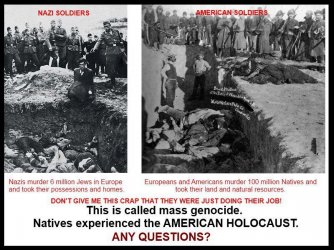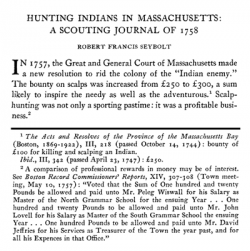A little more background on the American soldiers photo would be nice. Is this a battle, and which one. Remember, early Americans were killing each other long before the Europeans showed up on these shores and they were just as if not more cruel than the Europeans.
This is the aftermath of the
Massacre at Wounded Knee, in 1890-though, like Sand Creek, it was called a "battle" by some at the time. In the photo, U.S. soldiers pose over a mass grave trench with some of the 300 bodies of innocent Native American Lakota Sioux, two-thirds women and children, massacred at Wounded Knee, Pine Ridge Reservation. One of the few survivors of the massacre was a baby girl, found 4 days after the massacre, lying beneath her mothers dead frozen body, her mother having protected her in death as she had in life. The baby girl, having survived the massacre and the blizzard with temperatures at 40 below zero, was then abducted by Brigadier General Colby as a trophy of the massacre, in his own words "a most interesting Indian relic."
Of course, these events occurred more than 100 years ago, and comparing them to Nazi atrocities has nothing whatsoever to do with the "American fighting man
of today," or one's respect for them-asking "devotion," might just be asking to much, though, in the case of one of my oldest friends, Major General Kenneth Dahl (who is
still just "Kenny" to me), it wouldn't be. Nor would it be in the case of the many close friends I have who are actively serving, or retired career military. Nor would it be in the case of some of my son's and daughter's friends and classmates-some of whom are no longer among the living.
Of course, I worked in a fairly close relationship with members of all of our branches of the military-with the exception of the Coast Guard, which doesn't have any nuclear weapons. I've even had short collaborations with members of the British military.
Impugning my respect for the U.S. military is not only completely insulting and fallacious, it's downright moronic.:angry:
As is, btw, your trying to color the Sand Creek Massacre as anything but what it was: the action of drunken soldiers, under orders from a meglomaniacal Methodist minister, perpetrated under mostly old men, women and children, who were camped under what they thought was the protection of the
American flag. All of this is well documented, both in congressional testimony and the newspapers of the time. Soldiers paraded through Denver afterward with the removed,genitals of women displayed on their hats, and the skins of children stretched across their saddles.
WHen asked why he ordered the killing of children, Chivington had this to say:
Which was only one of the worst things he said, but amply proves my point about dehumanization of targeted individuals and groups.
:angry:


